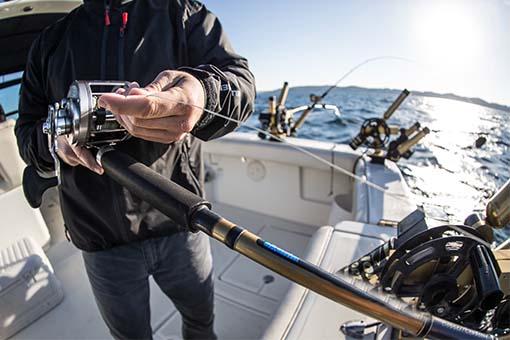Fishing for Catfish
Many anglers simply love catfish. There are 37 catfish families, with species found in both freshwater and saltwater. Perhaps their most recognized traits are their catlike whiskers, or barbells, and their lack of visible scales. Catfish have numerous external taste buds, many of which are located on the barbels. They can taste something by simply touching it with their barbels.
During the day, catfish hide around submerged rocks and logs, but at night they seek open water to find food. Catfish are generally plentiful and are found in various areas throughout the world although certain types of catfish stay within certain regions. They vary in size, depending on their age and species, and range from a few inches to a few feet and eat a variety of foods such as smaller fish and water insects.
Fishing for catfish at night can give the best results since they tend to hide during the daylight. Use live bait such as shrimp, chicken liver, and worms, and spoons, jigs and spinners.
Catfish Species
Read about different types of catfish. Find out where freshwater and saltwater catfish live, know the best bait for catching catfish depending on the species, and learn helpful fishing tips to help will help you reel them in.
Blue Catfish
Ictalurus furcatus
AKA: Channel cat, hump-back blue
AKA: Channel cat, hump-back blue
-
Distinguishing Markings:
Blue catfish are members of the bullhead catfish family, with long slender bodies and barbels on the chin that look like long black whiskers. There are four pairs of barbels around the mouth, two on the chin, one at the angle of the mouth, and one behind the nostril. Blue catfish have an adipose fin and a single, serrated spine in the dorsal and pectoral fins. They are generally slate blue on the back to silvery white on their bellies with a deeply forked tail. Their eyes are placed in the lower half of the head.
-
Size:
Blue catfish are the largest of the catfish family in North America and can attain weights in excess of 100 pounds. The sportfishing record is a specimen from Illinois that weighed 124 pounds.
-
Distribution:
The native range of blue catfish extends from Minnesota and Ohio southward into Mexico. They prefer the large river basins of the Ohio, Mississippi and Missouri River drainages; however, due to extensive introductions, their current range includes several Atlantic drainage systems as well.
-
Habitat:
Blue catfish live mainly in fresh water and prefer large rivers having deep channels with a swift current and a sandy bottom. They seek cool water in the summer and warmer waters in the winter. Although blue catfish have poor eyesight, their barbels are well equipped with taste buds which help them find food in dark waters.
-
Food:
Blue catfish are omnivorous feeders with highly varied diets that include fish, crustaceans, insects, mollusks and plant matter.
-
Spawning:
Blue catfish spawn in early summer and spawning success is dependent on available cover. They select nest sites in dark depressions, under rocks, cavities, or undercut stream banks, or inside crevices, hollow logs, or man-made containers. Upon hatching, catfish fry sometimes aggregate in tight schools after leaving the nest until suitable cover is found. Both parent fish assist in rearing the young.
-
Catfishing Tips
Blue catfish are very good to eat. Fresh baits such as cut fish, shrimp, chicken liver, and processed catfish bait are best, while bait casting and bottom fishing are popular angling methods.
Channel Catfish
Ictalurus punctatus
AKA: Forked tail, blue-channel cat, spotted cat, river cats
-
Distinguishing Markings:
Channel catfish are members of the bullhead catfish family and are a freshwater species that are commonly found in estuarine waters. Like the blue catfish, channel catfish are long and slender with four pairs of barbels around the mouth, two on the chin, one at the angle of the mouth, and one behind the nostril. They also have an adipose fin as well as a single, often serrated spine in the dorsal and pectoral fins. The channel catfish is generally gray to greenish-gray on the upper part of its slender body, silver to white on its lower half and belly and has a deeply forked tail. Small adults and juveniles have black or dusky spots on their body.
-
Size:
One of the largest catfish species found in North America, channel cats and can weigh more than 50 pounds. The sportfishing world record is a specimen from South Carolina that weighed 58 pounds.
-
Distribution:
The native range of channel catfish extends from southern Canada, through the Great Lakes and central United States drainage system, to Mexico including all the Gulf States and some of the Atlantic coast. Due to extensive introductions, their current range includes all of the Pacific and Atlantic drainage systems in the 48 continental states. Channel cats can live successfully in tidal as well as non tidal waters.
-
Habitat:
Channel catfish live mainly in fresh water and prefer deep pools around logs, rocks and other structure where they can hide.
-
Food:
Catfish are primarily omnivorous bottom feeders that feed at night. Common food items include aquatic plants and seeds, fish, mollusks, insects and their larvae, and crustaceans. Although channel catfish have poor eyesight, their barbels are well-equipped with taste buds which help them find food at night and in muddy waters.
-
Spawning:
Channel catfish spawn in late spring when water temperatures reach 75oF and lay approximately 2,000 to 21,000 eggs in turbid tributaries. It is not uncommon for the male fish to spawn with more than one female. These fish select nest sites in dark depressions, cavities, undercut stream banks, or inside crevices, hollow logs, or man-made containers. Spawning success is dependent on available cover. Upon hatching, catfish swim sometimes aggregate in tight schools after leaving the nest until suitable cover is found. Fingerlings school together during daylight hours and disperse and feed at night.
-
Fishing Tips:
Channel catfish are very good to eat. Fresh baits such as peeler or soft crab, shrimp, squid, chicken liver, processed catfish bait, hot dogs and cut fish are good baits and popular angling methods include bait casting and bottom fishing.
White Catfish
Ameiurus catus
AKA: Mudcats, cats
-
Distinguishing Markings:
White catfish are members of the bullhead catfish family, and are the smallest of the large North American catfish species. The white catfish has white chin barbells, which distinguish it from other species. There are four pairs of barbels around the mouth, two on the chin, one at the angle of the mouth, and one behind the nostril. As with the other large catfish species, white catfish have the adipose fin and the single, often serrated spine in the dorsal and pectoral fins. White catfish are bluish-gray on their back and sides and white underneath. Their tail is moderately forked and they have a noticeably broad head, large mouth and stout body and are smaller in size than channel catfish.
-
Size:
White catfish rarely exceed 6 pounds and 24 inches long. Average size is about 13 inches.
-
Distribution:
White catfish inhabit fresh and brackish water bodies along the Atlantic and Gulf coast states from New York to Florida, and are native to the Chesapeake Bay system. White catfish have been introduced into the mid-west and along portions of the west coast of the US.
-
Habitat:
White catfish are primarily a tidal water species that inhabits waters having a salinity of 5 percent, but also is found in freshwater lakes, ponds, rivers and streams. Their habitats include sluggish, mud-bottomed pools, open channels, and backwaters of small to large rivers.
-
Food:
White catfish are omnivores that feed on anything from fish to insects to crustaceans.
-
Spawning:
White catfish spawn in early summer when water temperatures reach 68 to 72 degrees F in still or flowing waters near sand or gravel banks. Both parent fish fan the bottom with their tails, creating large, saucer-shaped nests. Several thousand eggs are deposited in the nest and are guarded until they hatch, which usually occurs within 6 to 7 days. Males may remain close to the fry until they stop schooling and disperse.
-
Fishing Tips
White catfish are very good to eat. Fresh baits such as worms, shrimp, chicken liver, processed bait and cut fish are popular for bait casting and bottom fishing.

